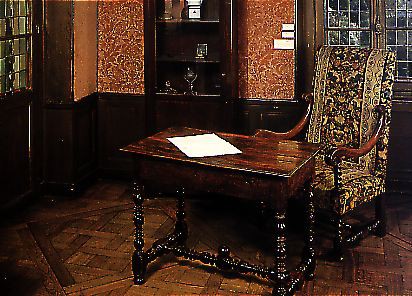Honoré de Balzac lived in this house from 1840 to 1847. Of the eleven Parisian residences of the writer, it is the only one which exists today. This house is also a witness to that which made the village of Passy during the last century: a place of holiday for city dwellers yearning for the country. Situated on the banks of the Seine, on a hillside, Balzac's house was officially transformed into a museum in 1949. It is the seat of the Balzac Studies Group and of the Balzac Society of Friends.
Balzac took refuge in this dwelling in 1840 after having left the Jardies, at Sèvres, which was seized by creditors. At the epoch, the house was concealed by another building, a hotel into which it was necessary to enter, go down two floors and then give a password in order to arrive at the author's pavilion. Living under the borrowed name of Mr. Brugnol (the name of his housekeeper-mistress!), Balzac composed in this place a large part of his monumental masterpiece, La Comedie Humaine. La Rabouilleuse (The Black Sheep), Le Curé de Village (The Village Priest), Les Paysans, Ursule Mirouet, Honorine, Mémoire de Deux Jeunes Mariées, Modeste Mignon, Splendeurs et Misères des Courtisanes (A Harlot High and Low), La cousine Bette (Cousin Bette), Le Cousin Pons (Cousin Pons) and Une Tenebreuse Affaire (A Murky Business) were also all written in this house.
Balzac wished to equal, through his writing, the work accomplished by the Emperor. In 1825, he had the “honour” of becoming the lover of one of the former glories of the Empire, the Duchess d'Abrantès, widow of General Junot. Thanks to her secrets and memories, he approached closer to this period of French history. She inspired him in the drafting of La Physiologie du Mariage (Physiology of Marriage), and, in exchange, he helped her write her memoirs which appeared from 1831 to 1835.
Balzac's househas conserved its general aspects. If the furniture has almost disappeared because of later moves, the rooms have kept their proportions, their fireplaces and their ceiling decoration. The museum visit starts in the vestibule with an evocation of the writer and of the quarter, then, in Balzac's bedroom, with that of his family and of his close friends. Notably, his famous gold and turquoise knobbed cane is exhibited there.
In the former living room, the memory of Madame Hanska, “the foreigner” who became Madame Balzac a few months before the death of the writer, is rekindled. Through a hallway, one reaches the study, the most moving room of the house with its stained-glass windows, its black marble fireplace, its Versailles parquet, and above all Balzac's armchair and table, of which he wrote: “I possessed it for ten years, it saw all of my misery, wiped away all of my tears, knew all of my projects, heard all of my thoughts. My arm almost wore it out moving back and forth over it as I wrote.”
The other rooms very richly illustrate the work and the life of the writer while a documentation centre, consisting of a library and an etching room, possess a collection of studies dedicated to the illustrious writer and a beautiful collection of first editions.
Home of Balzac


